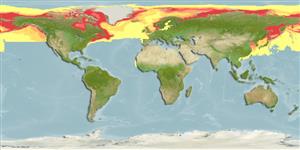Common names from other countries
Environment: milieu / climate zone / depth range / distribution range
Ecologia
Batidemersal. Polar; 90°N - 0°S, 180°W - 180°E
Northeast Atlantic, Atlantic Ocean, Pacific Ocean and the Arctic: Svalbard, Hudson Bay and Strait (Canada), Bering and Baltic Seas (Ref. 1394). Pusa hispida hispida: Arctic Ocean, Bering Sea, North Pole, James Bay and Baffin Island (Nunavut), Strait of Belle Isle (Newfoundland), Greenland, Barents Sea, Norway, White Sea, Kamchatka, Bristol Bay in Alaska, and vagrant to Azores, Germany, Portugal, New Jersey, Southern California; Pusa hispida botnica: Baltic Sea, Gulf of Bothnia and Finland, Sweden, Latvia; Pusa hispida ladogensis: Russia, Gulf of Finland, Lake Ladoga, White Sea; Pusa hispida saimensis: Finland; Pusa hispida ochotensis: Sea of Okhotsk, Japan, Russia, Kamchatka, and vagrant to Jiangsu, China (Ref. 1522). Climate: Circumpolar, subtropical, boreal.
Length at first maturity / Tamanho / Peso / Idade
Maturity: Lm ? range ? - ? cm Max length : 165 cm TL macho/indeterminado; (Ref. 1394); Peso máx. publicado: 110.0 kg (Ref. 1394)
Feeds on fishes and planktonic crustaceans (Ref. 1394). Incidental injuries and death of this species are caused by commercial fishing gears, i.e., flatfish trawl, pollock trawl, cod trawl, and cod longline (Ref. 118427). Typically stays in ice-covered waters year-round (Ref. 117965). Feeds on fishes (Ref. 1394) and planktonic crustaceans like pelagic amphipods and mysids (Ref. 117965).
Jefferson, T.A., S. Leatherwood and M.A. Webber. 1993. (Ref. 1394)
Categoria na Lista Vermelha da IUCN (Ref. 130435)
Categoria CITES (Ref. 108899)
Not Evaluated
Not Evaluated
Utilização humana
Pescarias: espécies comerciais
FAO - pescarias: landings, perfil da espécie | FishSource | Sea Around Us
Ferramentas
Fontes da internet
Estimates based on models
Preferred temperature
(Ref.
115969): -1.8 - 4.1, mean -0.4 (based on 11480 cells).
Resiliência
Médio, tempo mínimo de duplicação da população 1,4 - 4,4 anos (K=0.08-0.43).
Vulnerabilidade
High to very high vulnerability (66 of 100).
Categoria de preço
Unknown.
